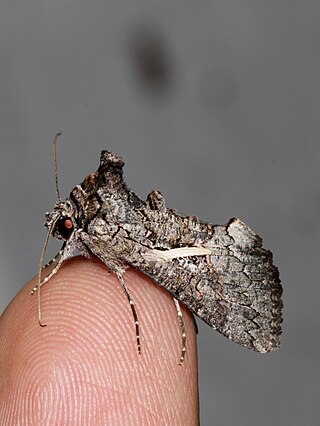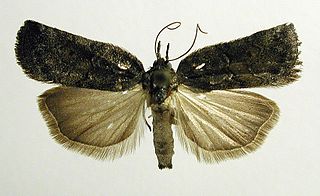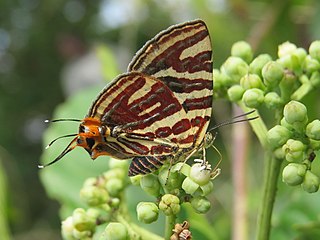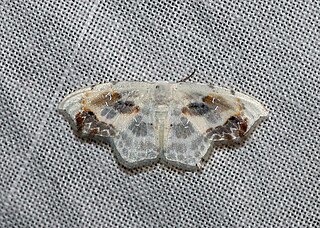
Discolampa ethion, the banded blue Pierrot, is a contrastingly marked butterfly found in South Asia that belongs to the blues or family Lycaenidae. The species was first described by John O. Westwood in 1851.

Neptis nata, the clear sailer or dirty sailer, is a species of nymphalid butterfly found in south and southeast Asia.

Plusia festucae is a species of moth of the family Noctuidae. It is found throughout the Palearctic realm from Ireland to Japan.

Catocala nymphagoga, the oak yellow underwing, is a moth of the family Erebidae. It is found in Southern Europe, from Bulgaria up to the Iberian Peninsula and sometimes further north as a migrant. It is also found in North Africa and Asia Minor.

Eudocima materna, the dot-underwing moth, is a moth of the family Erebidae found in widespread parts of the world, mainly in tropical Asia extending to New Guinea and Australia as well as in Africa. Reports from the United States, Canada and the French Antilles are now considered to be Eudocima apta. The species can be differentiated from other Eudocima moths by the presence of small central black dot in each hindwing. The species was first described by Carl Linnaeus in his 1767 12th edition of Systema Naturae.

Mesapamea secalis, the common rustic, is a moth of the family Noctuidae. The species was first described by Carl Linnaeus in his 1758 10th edition of Systema Naturae. It is found in Europe, north-west Africa, Turkey and northern Iran.

Ctenoplusia accentifera is a moth of the family Noctuidae. It is found in South-Western Europe, Greece, Africa, the Near East and Asia Minor.

Apamea scolopacina, the slender brindle, is a moth of the family Noctuidae. The species was first described by Eugenius Johann Christoph Esper in 1788. It is found across the Palearctic realm from central Europe to the Kuril Islands northeast of Japan.

Lygephila craccae, the scarce blackneck, is a moth of the family Erebidae. It is found in temperate Europe and across the Palearctic to the Altai Mountains, Korea, Japan and China.

Grammodes stolida, the geometrician, is a moth of the family Erebidae. The species was first described by Johan Christian Fabricius in 1775. It is found in Africa, southern Europe, most of Asia and Australia. It migrates to central and northern Europe as far north as England, Denmark and Finland.

Nycteola revayana, the oak nycteoline, is a moth of the family Nolidae. The species was first described by Giovanni Antonio Scopoli in 1772. It is found from Europe and east across the Palearctic to Japan and India.

Meganephria bimaculosa, the double-spot brocade, is a species of moth of the family Noctuidae. It is found in most of Europe, in Turkey and the west of Iran. In Anatolia it is represented by the subspecies Meganephria bimaculosa pontica.

Cosmopterix lespedezae is a moth of the family Cosmopterigidae. It is known from the United States.

Cigaritis lohita, the long-banded silverline, is a species of lycaenid or blue butterfly.
Syllepte cometa is a moth in the family Crambidae. It was described by William Warren in 1896. It is found in Assam, India.

Leucoblepsis renifera is a moth in the family Drepanidae. It was described by Warren in 1900. It is found on Peninsular Malaysia, Sumatra and Borneo.
Nordstromia humerata is a moth in the family Drepanidae. It was described by Warren in 1896. It is found in north-eastern India.
Callidrepana splendens is a moth in the family Drepanidae first described by Warren in 1897. It is found on Peninsular Malaysia and in Indonesia.
Phalacra albilinea is a moth in the family Drepanidae. It was described by Warren in 1899. It is found in India.

Hyssia cavernosa is a species of moth belonging to the family Noctuidae.














